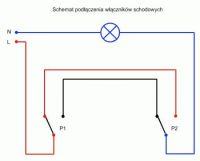Hello
I have a problem with the stair switch. Two stair switches in the corridor, one lamp (ordinary light bulb). After turning on the light with one switch, it cannot be turned off with the other (the bulb seems to tremble, but it is still on). The second switch, on the other hand, operates only with one setting of the first.
Everything has been working fine so far, the problem appeared suddenly, overnight, there were no changes in the installation in the meantime, I did not disconnect anything for painting, etc.
My first thought was to damage the switch, I bought a new one, replaced it (identical switches, wires connected the same) the problem is still there.
Below I put all combinations of switches, the letter "P" marked which wires are live.

From what I have read here on the forum, I already know that the wrong colors of the wires were used (this is how the installation was done) - but this is not the cause of the problem
Probably the brown wire in the switch 1 is the main current wire (constantly live, the same contact is connected to the wire leading to other rooms).
According to the diagrams that I found on the internet, the brown wire from switch No. 2 should lead directly to the lamp, but after it is completely disconnected, I can turn on the lamp with switch No. 1.
A standard 3-color wire is connected to the lamp, when the light is on, the voltage is always on brown.
I do not know if it matters, but in the box behind the switch No. 1 I have connected cubes:
- 3 blue wires
- 3 green-yellow wires
- 2 brown wires
What could be the cause of the problem, what should I check next?
Thanks in advance for your help and any suggestions.
Regards
Mark
I have a problem with the stair switch. Two stair switches in the corridor, one lamp (ordinary light bulb). After turning on the light with one switch, it cannot be turned off with the other (the bulb seems to tremble, but it is still on). The second switch, on the other hand, operates only with one setting of the first.
Everything has been working fine so far, the problem appeared suddenly, overnight, there were no changes in the installation in the meantime, I did not disconnect anything for painting, etc.
My first thought was to damage the switch, I bought a new one, replaced it (identical switches, wires connected the same) the problem is still there.
Below I put all combinations of switches, the letter "P" marked which wires are live.

From what I have read here on the forum, I already know that the wrong colors of the wires were used (this is how the installation was done) - but this is not the cause of the problem
Probably the brown wire in the switch 1 is the main current wire (constantly live, the same contact is connected to the wire leading to other rooms).
According to the diagrams that I found on the internet, the brown wire from switch No. 2 should lead directly to the lamp, but after it is completely disconnected, I can turn on the lamp with switch No. 1.
A standard 3-color wire is connected to the lamp, when the light is on, the voltage is always on brown.
I do not know if it matters, but in the box behind the switch No. 1 I have connected cubes:
- 3 blue wires
- 3 green-yellow wires
- 2 brown wires
What could be the cause of the problem, what should I check next?
Thanks in advance for your help and any suggestions.
Regards
Mark




